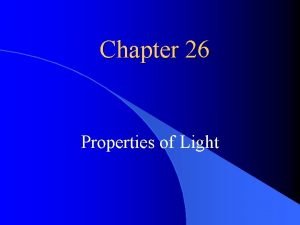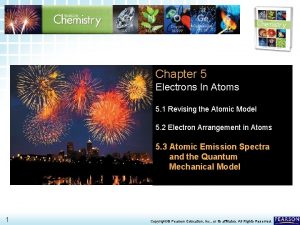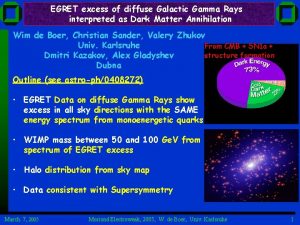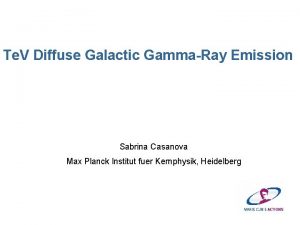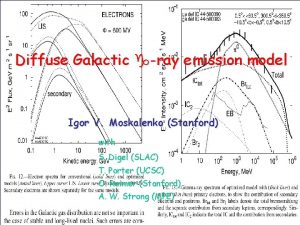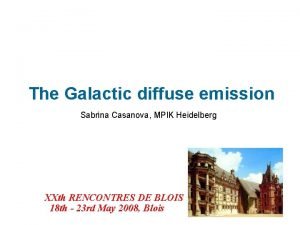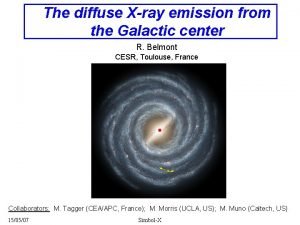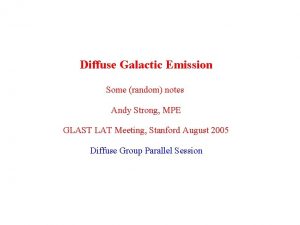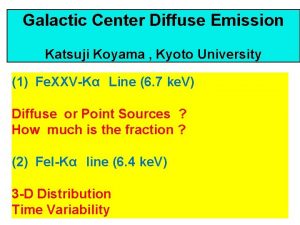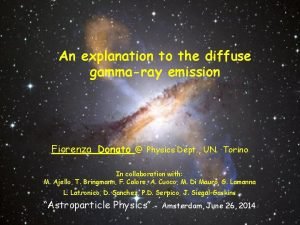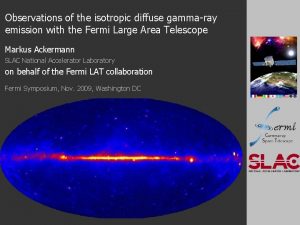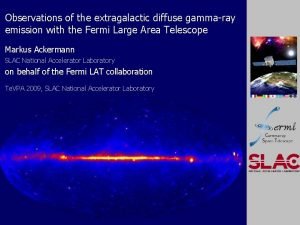Galactic Diffuse Gammaray Emission the EGRET Model and












- Slides: 12

Galactic Diffuse Gamma-ray Emission, the EGRET Model, and GLAST Science Stanley D. Hunter NASA/GSFC Code 661 sdh@gamma. gsfc. nasa. gov July 23, 2004

The Galactic Diffuse Gamma-ray Emission. . . the dominant feature of the gamma-ray sky and a probe of the Galactic ISM and the CR distributions Galactic ridge Tangent points of the local arm July 23, 2004 High latitude (halo? ) Inter-arm region 2

EGRET/GLAST Diffuse Emission Model • Relation to the EGRET/GLAST Science: – Study the physical structure of the interstellar medium (ISM) in the Milky Way and the distribution of matter and CRs that pervade it – ‘Background’ model for point source analyses • EGRET model - Calculation from first principles – Two components Galactic Diffuse, |b| < 10 o + Isotropic Diffuse model, |b| > 10 o (Hunter et al. 1997, Ap. J, 481, 205) (Sreekumar et al. 1998, Ap. J, 494, 523) – Model used for all EGRET Source Catalogs (e. g. Hartman, 1999, Ap. JS, 123, 79) – Common CR distribution, emission discontinuous at |b| = 10 o • ‘Eliminated’ by PSF convolution – GALDIF model extended to all-sky for GLAST model • GLAST 2 nd Data Challenge - Feb. 2005 July 23, 2004 3

EGRET/GLAST Diffuse Emission Model • Inputs to model: – Gamma-ray production processes in the ISM • Pion production, Bremsstrahlung, inverse Compton scattering – Tracers of the ISM (matter and radiation) + Galactic rotation curve 3 -D ISM distribution • HI (21 cm), H 2 (115 GHz CO), HII (pulsar dispersion), low-energy photon density – Physical parameters: More on the ISM. . . • N(HI)/WHI conversion factor, CR spectrum, e/p ratio, interaction cross-sections, Galactic rotation curve, etc. More on dynamic balance. . . – Model assumptions: • Assume the CRs are in dynamic balance with ISM • There are only two adjustable parameters in this calculation! – Molecular mass ratio, X=N(H 2)/WCO, CR coupling scale • Discrepancies between model and observation are directly interpretable in terms of model inputs and parameters. July 23, 2004 4

Composition of the ISM - Matter & Radiation • Interstellar Clouds 0. 011 M /pc 3, ~90% of ISM – Bright Nebulae, e. g. Orion (M 42) – HI 8 H-atoms/cm 3, 0. 01 elec/cm 3 – All other elements – Dark Nebulae, e. g. Ophiuchus – H 2 1 H-mol/cm 3 – HII ~8 elec/cm 3 • Interstellar Gas – Mean density between clouds 0. 1 H-atoms/cm 3, 0. 035 elec/cm 3 • Interstellar Grains 0. 0015 M /pc 3, ~10% of ISM – Number density 0. 5 x 10 -12 cm-3 • Stellar radiation – CMB (2. 7 °K) • Turbulent gas motion • Cosmic rays • Magnetic field Mass density ~1 g/cm 3 7 10 -13 erg/cm 3 4 10 -13 erg/cm 3 5 10 -13 erg/cm 3 16 10 -13 erg/cm 3 15 10 -13 erg/cm 3 • Should this list also include dark matter? July 23, 2004 5

Cosmic Rays and Matter - Dynamic Balance • Cosmic rays are Galactic, not universal (Sreekumar et al. 1992; 1993) • The cosmic ray and magnetic fields are in a quasi-stationary state, dynamic balance (Parker 1969) – The CR pressure may not exceed the magnetic field pressure (Parker 1968) and appears to be close to the maximum • The Galactic magnetic field is confined to the disk by the weight of the interstellar gas • CRs (at least < 1016 -17 e. V per nucleon) are bound to the lines of force and the lines of force are normally closed • CR age, based on isotopic abundance, is slightly more than 107 years – Consistent with secondary abundance and Galactic matter density – Slow diffusion rate in magnetic field and small anisotropy • Energy density of the cosmic rays is larger where the matter density is larger on some coarse scale - Dynamic Balance • Unanswered questions: – What is the CR/matter coupling scale? What is the vertical scale height? July 23, 2004 6

CR Distribution from Dynamic Balance • Derive 3 -D distributions of HI, H 2, and HII • Determine Galactic mater surface density, normalize total Solar density to unity, ce = cn = c(l, ) • CR density at l, is then Solar CR density c(l, ) • The diffuse emission is (Matter density)2 • CR scale height assumed to be large compared to matter scale height July 23, 2004 7

The Galactic Diffuse Emission Straight forward integral over the line-of-sight: Galactic cosmic-ray distribution of electrons and nucleons (+ He, heavies) Gamma-ray production functions electron bremsstrahlung, nucleon (πo), and inverse Compton Synchrotron emission is not significant Galactic matter distribution of atomic, molecular, and ionized hydrogen Low-energy photon energy density cosmic microwave background, infra-red, visible, and ultraviolet The hard part: determining the 3 -D matter, ISR, and CR distributions. July 23, 2004 8

Comparison with EGRET Observation - 1 July 23, 2004 9

Comparison with EGRET Observation - 2 EGRET data from Phases I+II Source subtraction by J. Cattelli, 1995 July 23, 2004 10

Galactic Pole Emission Extra-galactic diffuse July 23, 2004 11

Conclusions • Some adjustments still needed: – CR electron scale height or low-e photon density too low – Extension of emission above 30º to 90º • GALDIF, all-sky calculation provides an accurate, easy to use model of the Galactic Diffuse Emission – Discrepancies are directly interpretable in terms of calculation inputs and assumptions • Preliminary FITS files are available now! July 23, 2004 12
 Cattle egret and cattle symbiotic relationship
Cattle egret and cattle symbiotic relationship Multiple nuclei model example
Multiple nuclei model example Three models of urban structures
Three models of urban structures Galatic city model
Galatic city model Eggs hearse sized hay lee
Eggs hearse sized hay lee Snowy egret symbolism
Snowy egret symbolism Canoe key pass egret answer
Canoe key pass egret answer Egret chapter 26
Egret chapter 26 Egret chapter 23
Egret chapter 23 Egrette chapter 22
Egrette chapter 22 Egrette ch 22
Egrette ch 22 Chapter 16 biotechnology
Chapter 16 biotechnology Atomic emission spectra and the quantum mechanical model
Atomic emission spectra and the quantum mechanical model







